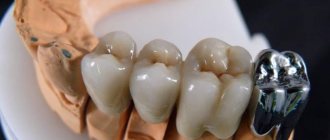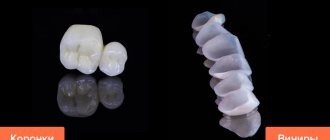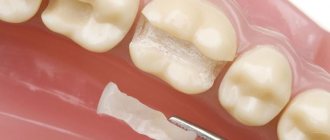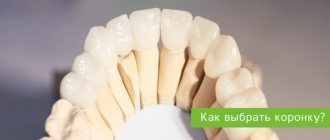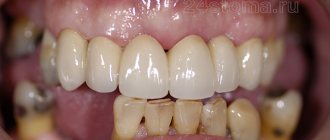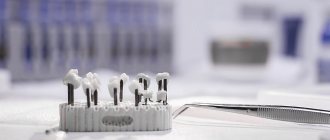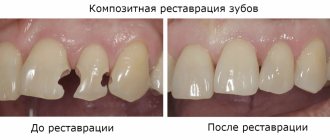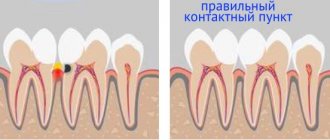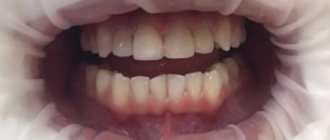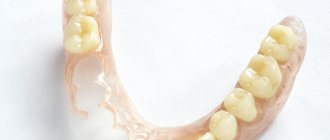30.11.2019
Tooth loss can be associated with oral diseases or old age. Sports and other injuries often lead to their loss. Whatever the reason, modern dentistry has in its arsenal enough options for individual solutions in the form of prosthetics using various materials.
Two types of dental structures are used in prosthetics
- REMOVABLE
- FIXED
Materials for making a prosthesis can be:
- Plastic – for short-term use on chewing teeth or on the front teeth, where the mechanical impact is several times less;
- Metal – considered stronger and more durable. Not suitable for people with allergies to metal. Manufactured in a one-piece version and stamped by soldering;
- Ceramics are well suited for prosthetics in those areas that are visible to others, since during manufacturing the natural color of existing teeth can be easily matched. The appearance completely reproduces the natural dentition;
- Mixed composite materials - metal-ceramics, metal-plastic.
Metal-ceramics and metal-plastic are a combined material; each of them has positive and negative characteristics. Which artificial teeth, made of metal-ceramics or metal-plastic, is best to choose? To answer this question, it is worth studying each material in detail.
Types of Best Dental Crowns for 2021
Modern dentistry offers patients crowns made from various materials. It is this indicator that is key in determining the cost, quality parameters and indications for the use of a particular prosthesis. Another important criterion on which the quality of a product depends is the production method.
The following crowns are currently in demand:
- Metal-ceramic. They are among the most popular prosthetic devices. Includes a metal base and an outer facing layer of ceramics. Initially, the frame is made, after which the ceramic coating is performed. The production process can be carried out on the basis of modern computer programs and aesthetic modeling.
- All-ceramic. In the manufacture of such prostheses, metal-free ceramics are used. Provides maximum safety in relation to soft tissues, which is due to the biological inertness of this material. The manufacturing process is based on the firing technique; ceramic pressing technologies; use of milling equipment and modern digital programs.
- Crowns made of zirconium material. Despite its origin (metal), zirconium dioxide is famous for its unrivaled aesthetics and increased safety. The manufacturing process is based on the use of specialized digital programs and milling equipment. Two versions of such prostheses can be used: combined (include a base of zirconium material and ceramic lining) and monolithic (made of zirconium oxide without the use of a ceramic coating).
- Glass ceramics e.max. It is distinguished by perfect aesthetic parameters and the necessary strength. There are currently 2 material options in use: E.max RPESS - produced by injection molding using elevated pressure and temperature conditions, and E-max CAD - produced using modern digital applications and milling machines (CAD/CAM concept).
How metal-ceramic crowns are made
After diagnosing a clinical case and justifying the need for crown prosthetics, impressions of the patient’s teeth are taken. Based on the impressions, the dental technician makes a metal frame or base of the prosthesis. Next comes the second stage - coating the metal cap with ceramic lining. The ceramic layer is responsible for the natural and natural appearance of the future artificial tooth.
When the crown is ready, it is tried on the patient using temporary cement. It is important that a person feels comfortable using the denture so that it does not protrude and destroy the antagonist tooth. If the patient is satisfied with everything during fitting, the crown is attached with permanent cement. If there are any wishes, or the proper level of comfort is not provided, the crown is adjusted. Sometimes the correction can take place directly in the dentist’s office, for example, if it just needs a little filing. Otherwise, the prosthesis is returned to the dental technician, who remakes it using specialized equipment.
Comparative characteristics of the best crowns
To determine which crowns are the best , you need to study the pros and cons of each product, taking into account the material used.
Next, we will compare the key parameters of various prosthetic options:
| Crown | pros | Minuses |
| Made from metal-ceramics using precious metals | Has increased strength, has a natural appearance, does not cause allergization of the body | High price |
| Made from metal-ceramics using non-precious metals | It is famous for its sufficient strength, has a reasonable price and good aesthetic parameters | There is a possibility of allergy |
| Made of ceramic material | Features impeccable aesthetic parameters and absolute compatibility with the patient’s body | Increased fragility |
| Made of zirconium material | Excellent aesthetic properties, long period of operation, absolute compatibility with the body, absence of allergic reactions | Impressive value |
| e.max crowns | Unsurpassed aesthetics, increased strength, excellent light transmittance. Emax Press has a gradient of color and transparency. | High price. Only single crowns can be installed in the chewing region. |
What are the best crowns for chewing teeth?
In general, the controversial issue regarding which crown is best to place on chewing teeth may have a completely unambiguous solution. Since this department experiences increased chewing pressure, it is advisable to use high-strength and most reliable prostheses to recreate the missing units. However, despite the need to restore functional characteristics in this area, the aesthetic component should not be ignored. Moreover, making the right choice is also important from the standpoint of the biocompatibility of the material.
Next, you will get acquainted with detailed information regarding which crown is best to place on the chewing teeth, taking into account the material used:
- Metal ceramics . According to statistics, this material is among the most popular in orthopedic practice. First of all, this is due to the excellent quality and affordable prices for such crowns. As for the negative aspects, they include a significant likelihood of chipping, unlike traditional analogues. In addition, there is a risk of cyanosis appearing at the border of the gum and the prosthetic device, which has an undesirable effect on aesthetics;
- Dentures made of ceramic material . The possibility of using such crowns depends on their type. It is undesirable to fix standard ceramic structures in the masticatory region due to their significant fragility and increased likelihood of breakage. However, at the moment it has been possible to develop more durable crowns that make it possible to recreate the missing units in any area of the jaw. These include Emax and Empress glass-ceramic structures. But if you study dental crowns from the point of view of which ones are better, the price in this case is not a priority criterion (over 20,000 rubles per unit);
- Structures made of zirconium material . They allow you to recreate the missing units in the lateral section, since they are considered the most highly durable and durable prostheses. It is recommended to use monolithic crowns, which eliminates the possibility of using a porcelain coating and, as a result, minimizes the possibility of chipping. However, the price of such a prosthetic device can be higher than 30 thousand rubles;
- Emax crowns . Despite the exceptional aesthetics and excellent strength parameters (up to 400 MPa), such crowns are best used for the frontal area. For the chewing region, it is allowed to use single crowns made of E-max RPESS material obtained by pressing.
An alternative to crowns for chewing teeth
It should be remembered that even in the presence of significant damage, a tooth can be restored using a conventional light-composite filling and pin. If it is necessary to eliminate a single defect, implant fixation is recommended.
Which is preferable: a filling, a pin or a crown?
As mentioned earlier, with significant destruction of the coronal part of the tooth (more than 50%), it is possible to recreate it using a light-composite filling mass. In this case, a pin made of fiberglass or metal material is used, which allows for more reliable fixation of such a filling.
If the tooth crown is destroyed by more than 50%, experts recommend resorting to the use of a prosthesis. This primarily applies to units from which the pulp has been removed, as these are considered the most fragile.
Also, in case of significant destruction of the coronal part, dentists use a special stump insert, which ensures a more durable installation of the prosthesis.
What to choose: a crown or a dental implant?
When considering the replacement of missing units with crowns, implant fixation is the preferred option for eliminating a single defect. When using a dental structure, the need to prepare teeth that act as supporting elements is eliminated. In addition, implants have a longer period of use, in contrast to single prosthetic structures and bridges.
By number of missing teeth
Depending on the number of lost teeth, a specific prosthetic method is selected.
For minor losses in the dentition
It is advisable to use acrylic, clasp and bridge prostheses. The design on implants will also always remain relevant.
With complete edentia
fixed prosthetics will be more effective. The technology of prosthetics on implants “All-on-4” and removable structures on pins are considered the most effective methods of restoring dentition with significant losses. In some cases, the use of economical versions of acrylic or nylon is justified, but due to insufficiently reliable fastening in the oral cavity and uneven load distribution, orthopedists do not recommend them so often.
What are the best crowns for front teeth?
When we are trying to figure out how to choose the best crowns for the front teeth, the priority criterion is the aesthetic component. At the same time, prosthetic structures intended for the frontal region must have a natural appearance, fully correspond to natural analogues and have sufficient strength. However, when you plan to fix a crown on the front teeth, there is no point in asking: “Which dentures are better to install on the lower jaw, and which ones on the opposite side?”
In both cases, the same type of prosthetic device models are used. Below we will provide more selected information:
- Metal-ceramic crowns . Despite the reasonable cost, this is not a completely suitable option in terms of aesthetic parameters. Firstly, an undesirable bluish tint appears in the area where the prosthesis adheres to the gum. Secondly, the metal base can be viewed through the ceramic coating. Of course, today there are improved designs with shoulder mass, but their price will significantly exceed the cost of a standard crown;
- Dentures made of ceramic material . This is the most advantageous option in cases where a dilemma arises as to which crowns are best placed in the frontal part of the jaw. Moreover, for this department you can resort to the help of traditional prostheses made of all-ceramic material. Their cost is considered affordable for most patients;
- Zirconium crowns . This solution is considered one of the most expensive when it is necessary to reproduce anterior teeth. However, this option is considered preferable for those who want to find out which crowns are best to put on their front teeth, but for whom pricing policy does not matter;
- Emax crowns . Such designs are made from an improved material - glass ceramics, which has excellent aesthetics. In this case, it is advisable to choose the E-max RPESS Multi material, which has a gradient of color and transparency, which will allow you to recreate the lost frontal units with maximum identity.
Our clinics
Clinic "Elident" on Varshavskaya
Varshavskoe highway, 75, bldg. 1, Moscow 117556
- Varshavskaya (500 m, closed until 2021)
- Nakhimovsky Prospekt (1,300 m)
Mon-Sat : 09:00-21:00; Sun : 09:00-19:00.
Online registration
+7 (495) 649-41-19
Elident Clinic in Annino
Varshavskoe highway, 154, building 1, Moscow 117405
- Annino (500 m)
- Academician Yangelya (700 m)
Mon-Sat : 09:00-21:00; Sun : 09:00-19:00.
Online registration
+7 (495) 649-41-19
Alternative options to frontal crowns
At the moment, there are three alternative methods that allow you to restore the crown part of the tooth, with destruction of no more than 50%. These include:
- Veneers. Suitable for use if there is slight destruction of the outer surface of one of the front teeth. An important requirement for carrying out a procedure using such plates is the preservation of the tooth wall from the inside. Through veneers, unsurpassed aesthetics are achieved, the possibility of tooth preservation is ensured and it is possible to significantly extend the life of the tooth;
- Dental implants. If it is necessary to reconstruct 1-2 teeth and install bridge-like prosthetic devices, it is advisable to fix the implants instead of preparing the supporting units;
- Filling material. As mentioned earlier, the option with light-composite restorations is preferable when the coronal part of the tooth is destroyed by no more than 50%.
Implantation: indications and benefits
Implantation is the most advanced dental technique that allows you to insert a tooth in place of an extracted one.
- Implants eliminate dental defects of any location and extent.
- People quickly get used to the implants. There is no discomfort, no sensation of the presence of a foreign body in the oral cavity, no problems with chewing food.
- Before implantation, there is no need to grind and depulp adjacent teeth; they remain healthy.
- Implants do not need to be changed or adjusted. With proper implantation and personal hygiene, artificial roots can last a lifetime.
- Even under increased loads, there is no risk of implants falling out or loosening.
What crowns are best to put on implants?
When studying the question of which crowns are best placed on implants, one should remember the classic procedure for installing dentures. If it is necessary to recreate the missing units in the frontal region, experts give preference to the aesthetic component. The best dental crowns in this situation will be made from zirconium material or ceramic.
If you need to fix crowns on your chewing teeth, and you don’t know which ones are better, any experienced dentist will give clear advice - in this area it is advisable to install prosthetic devices made of metal ceramics, zirconium material or e.max glass ceramics. It should also be taken into account that adapters in dental structures, in the event of subsequent use of the above prostheses, must be obtained from materials that are unable to be seen through the ceramic layer.
Many patients are interested in which crowns are better, ceramic or zirconium, to be fixed to implants? According to leading experts, the most advantageous options include devices made from the innovative material E-max or zirconium dioxide.
Additionally, when evaluating whether metal-ceramic or zirconia crowns are better, it is important to consider the need for zirconia adapters. This will prevent the body from becoming allergic to metal, as well as obtain the desired aesthetic result.
How are dental implants inserted?
Implantation, in order to insert teeth, can be carried out in different ways: according to a one-stage or two-stage protocol. But its essence will always boil down to the following: in order to insert a lost tooth, the doctor will implant a special structure in the patient’s jaw - an implant, on which he will subsequently install a crown or prosthesis.
Until the stage of permanent prosthetics, you will walk with a temporary prosthesis, which is placed during one-stage implantation immediately after implantation. In two-stage implantation, immediate dentures are used to mask dentition defects.
A permanent crown or prosthesis is placed on the implant only after it has completely fused with the natural bone tissue of the jaw. Crowns for installation on an implant can be made from any material: for the restoration of front teeth, ceramic crowns are most often used, for the restoration of chewing units - products made of zirconium and metal-ceramics.
Which implantation technology should I choose to insert teeth? It is impossible to give any absentee recommendations on this matter. You need to visit the clinic, undergo an examination and diagnosis, and only after that the implantologist will offer you the optimal implantation method.
Prices for tooth crowns at Elident
When assessing dental crowns from the standpoint of which ones are better financially, one should take into account the material used, the technological solutions being implemented, the equipment used, as well as the level of professionalism of the specialist and the rating of the dental institution in which the teeth are restored.
The Elident clinic has affordable prices for all types of services related to the fixation of implants and the installation of dental crowns. At the same time, you can always count on an individual attitude and high professional training of dentists, which is combined with the use of highly effective innovative equipment and modern prosthetic concepts.
| Service | Price, ₽. |
| Consultation with an orthopedist | for free |
| Orthopantomogram - panoramic image of teeth | 950 |
| Metal-ceramic crown Degussa M with shoulder mass (Germany) | 10 500 |
| Ceramic crown Dutseram plus (Germany) | 20 500 |
| Solid crown | 5 500 |
| Ceramic crown made of zirconium dioxide | 32 000 23 000 |
| Empress crown | 19 000 |
| Metal-ceramic crown on an implant | 18 500 |
| Ceramic crown made of zirconium dioxide on an implant | 35 000 |
| Metal-ceramic crown on zirconium dioxide for Straumann implant (SPECIAL!!!) | 35 000 26 500 |
| Metal-ceramic crown on zirconium dioxide for implant Alpha Bio, BioLine, Osstem (SPECIAL!!!) | 35 000 25 000 |
| Temporary plastic crown/wedge. | 1700/1200 |
| Taking an impression from alginate mass | 300 |
| Diagnostic plaster model | 300 |
| Taking a double impression | 800 |
| Cementing inlays and crowns using Fuji cement | 700 |
| Cementing inlays and crowns using Fuji+ cement | 800 |
| Temporary cementation of one crown | 400 |
| Removing one crown with stamped sawing | 500 |
| Removing one crown with sawing the cast | 1 000 |
| Removing one crown with sawing MK | 800 |
Metal-ceramics or metal-plastic – what to choose?
You need to understand that metal-plastic crowns are not designed for long-term use; they are a temporary solution. By choosing metal-ceramic dental prosthetics, the patient receives the optimal price-quality ratio. These prostheses have a lot of advantages, and the cost is more than justified.
A doctor from our clinic will help you finally decide on the type of prosthesis. He will conduct a thorough examination and recommend the most suitable prosthesis for your case. He will also carry out the installation professionally. Modern equipment and the use of advanced prosthetic techniques, multiplied by many years of practical experience of our specialists, ensure painlessness throughout the entire process. We provide a guarantee for the installed prosthesis because we are confident in the high quality of work.
Service life of dental crowns
If you are interested in a tooth crown and what material is best for its manufacture, an important point is the service life of the product. For example, prosthetic devices made of metal-ceramics can be used for 8-10 years, zirconium structures - over 15-20 years, glass-ceramic products - over 15 years.
However, when studying the properties of dental crowns and trying to find out which ones are better suited for prosthetics in a particular area of the jaw, one should not forget about compliance with the patient’s care requirements and the quality of the procedure performed by the dentist.
Under normal conditions, assuming proper training of the doctor and strict compliance with the production concept, the service life of crowns cannot be less than 10 years.
Installation procedure
- The patient is examined by a dentist and sent for an x-ray in order to draw up a treatment plan, taking into account contraindications and wishes.
- The oral cavity is sanitized - professional cleaning is carried out, and, if necessary, treatment.
- The tooth is prepared for the installation of a crown - the pulp is removed (an optional requirement), the canals are processed and cleaned, and grinding is carried out.
- A cast is made from which a plaster model is cast.
- A crown is created. Modern technologies make it possible to achieve complete adherence of the crown to the tooth tissue. While the crown is being made, the patient is given a temporary onlay.
- Crown fitting. The product must comply with the existing parameters, cover the tooth completely, and not cause discomfort.
- Fixation is carried out with dental cement. This stage can be carried out in two steps: first, the installation is carried out using temporary cement, and the doctor observes the patient’s sensations for several weeks. If the result meets the requirements, the crown is permanently fixed.
When choosing a material for a crown, you should take into account the opinion of a specialist who will assess the condition of the teeth and find the best option, taking into account the patient’s wishes. In any case, the choice is made taking into account the requirements for increased loads.
Author:
Mayorov Andrey Mikhailovich
Specialization:
orthopedic dentistry, dental prosthetics, implant installation
Caring for tooth crowns
When studying the topic of dental crowns and trying to understand which ones are better, many rely on reviews from other patients and specialists. At the same time, any qualified doctor will tell you that to extend the life of a prosthetic device, you first need to pay attention to the rules of care.
For example, if you have a single crown installed, it is enough to carry out regular hygiene procedures using toothpaste, brush and dental floss. In the presence of bridge structures, as well as in patients with periodontal pockets in the area of dentures, it is necessary to resort to the help of irrigators. These devices help clean hard-to-reach areas from dental plaque and food debris.
Article expert (author):
